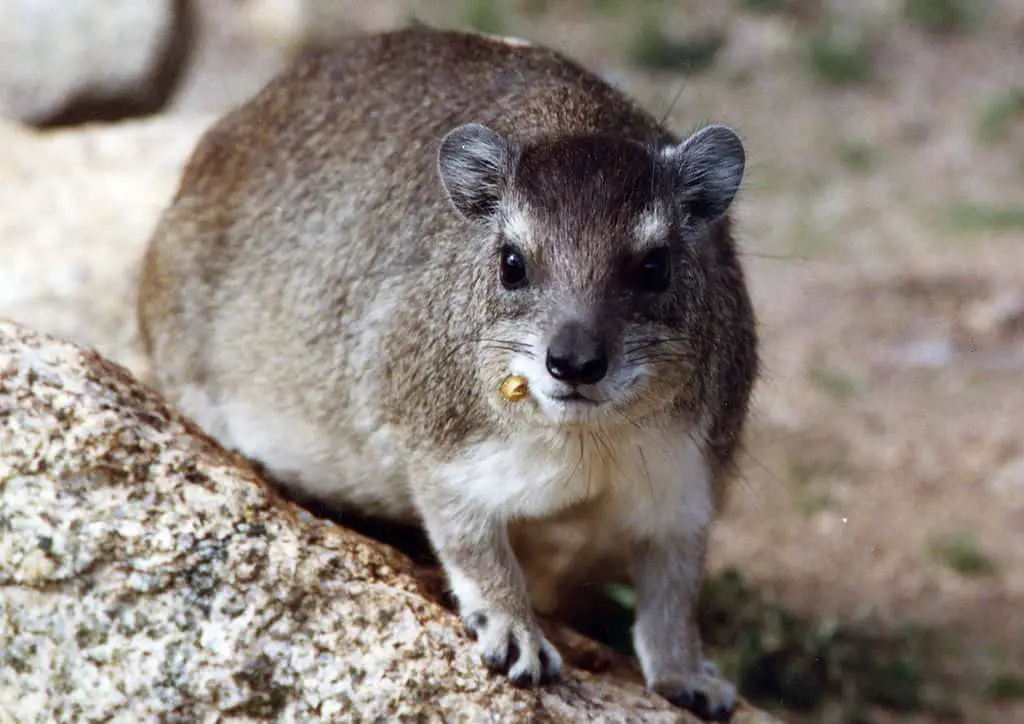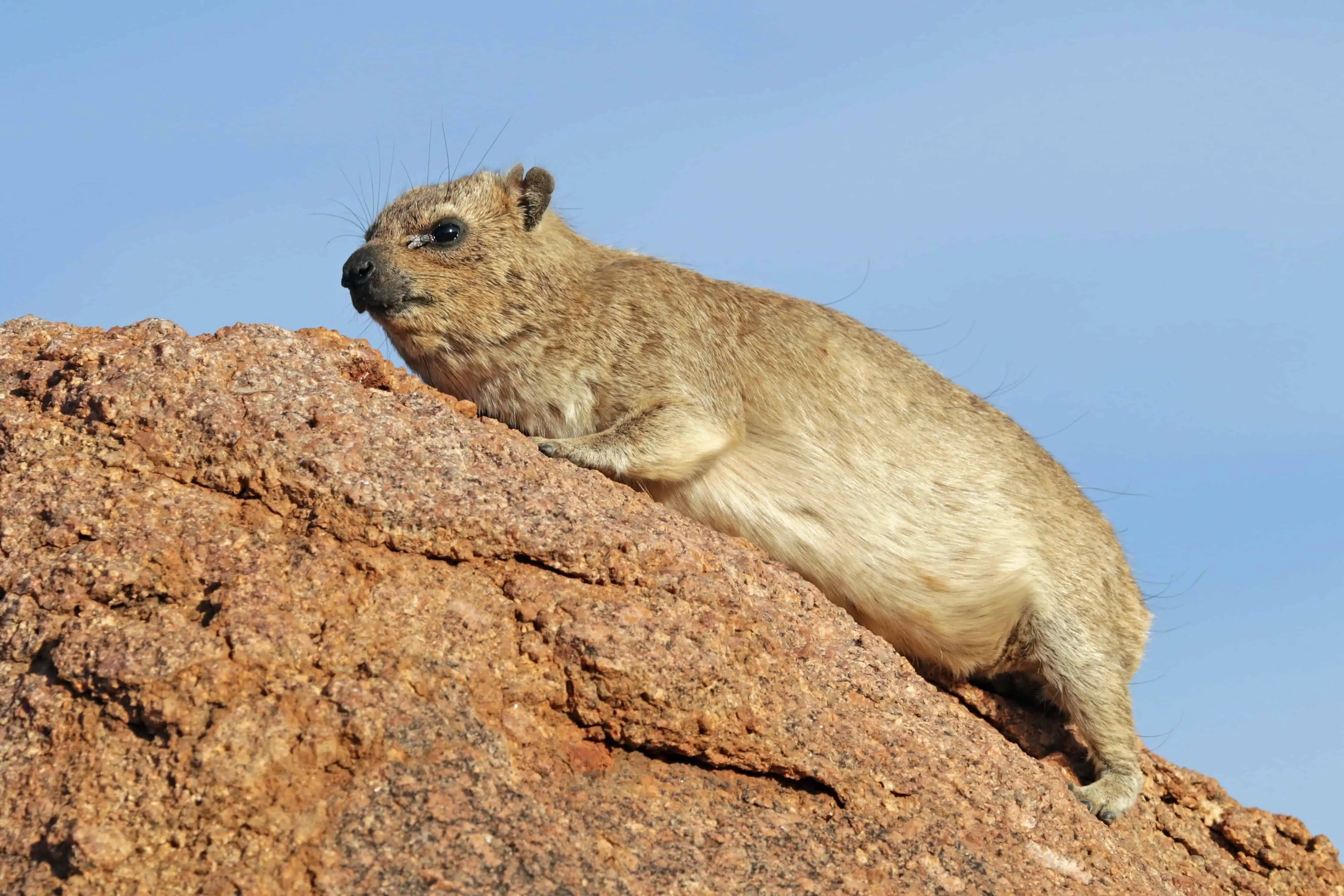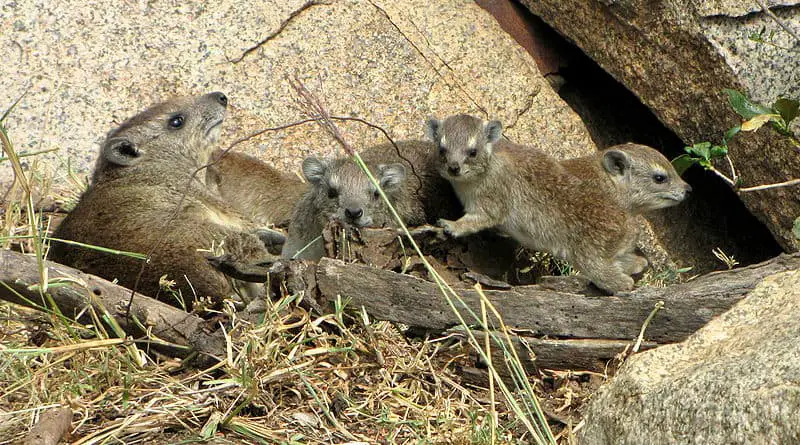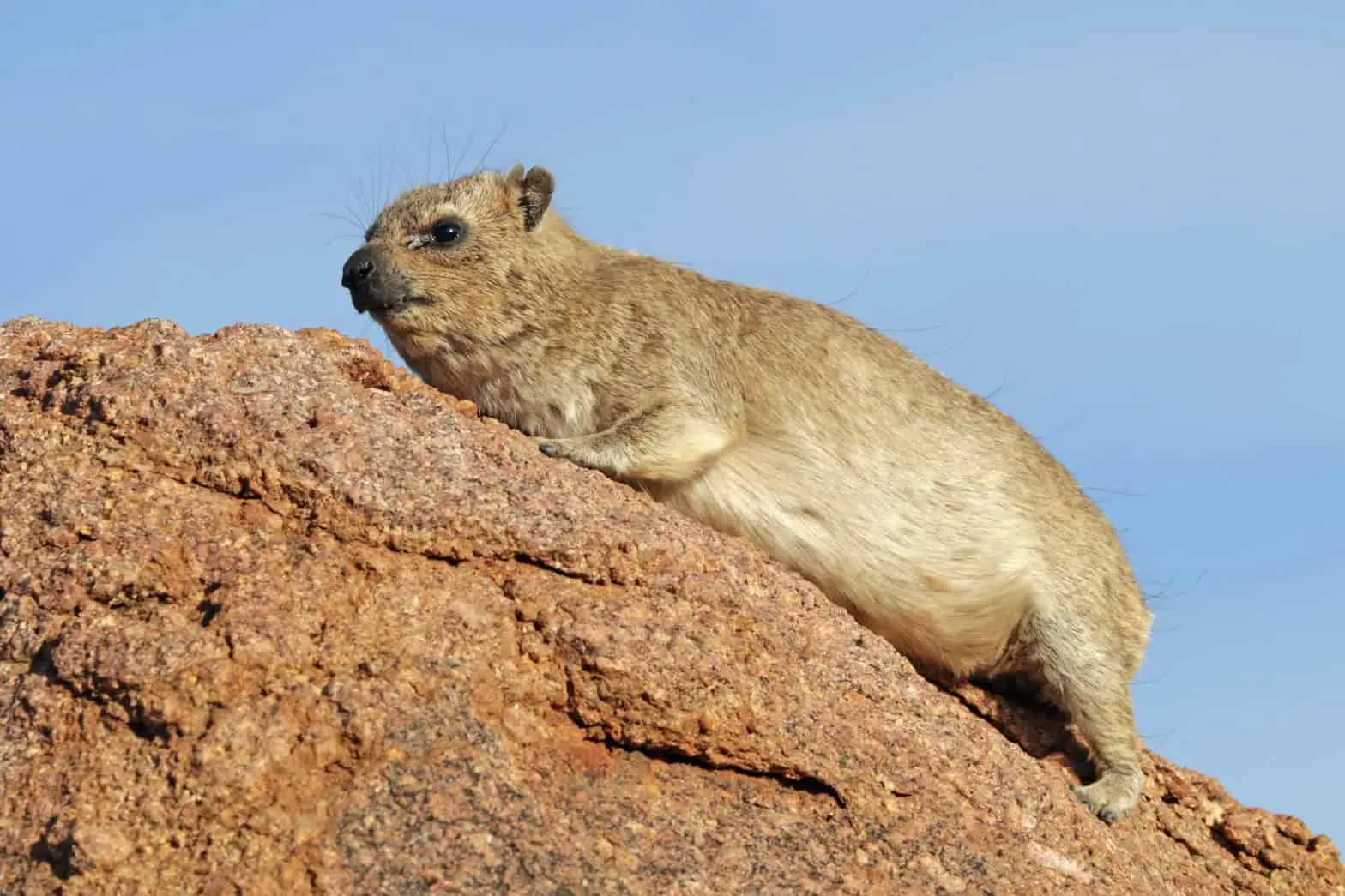Table of Contents
*This post may contain affiliate links. As an Amazon Associate we earn from qualifying purchases.
The hyrax is a small mammal that lives in a wide band across the middle of the African continent, as well as in South Africa and the Middle East. They are clever and socially structured with a complicated communication system. They can be a pest in farming regions, but are fondly looked out for in some city areas.

Interesting Facts About the Hyrax
What is a hyrax, you ask? Even though the name may sound like it, the hyrax is not a Dr. Seuss character. The scientific name is procavia capensis. In the Bible when it refers to coneys, it is speaking of the hyrax. The locals in South Africa affectionately refer to the cape hyraxes as dassies. The Swahili people call them pimbi or wabari. They are also known by the name of rock badgers or rock rabbits. In fact, they are mistaken for other animals depending on the angle from which they are seen; rats and rabbits are most common, but they can also resemble the Australian koala when perched in a tree, or even a cat when stretched out in the sun.
Appearance
Whatever you choose to call this mammal, the hyrax is a small, rodent-like animal with tiny pointed ears and large, almond-shaped eyes. When calm, the hyrax’s face is rather sweet and almost assumes a smile below its whiskered little black nose. But if you alarm it or make it angry, the hyrax opens its mouth wide, bearing its sharp little tusks and sticking out its tongue, flaring its nostrils, and while glaring at you with squinted eyes, it transforms from its storybook-like sweetness to an angry Japanese animè-style character. This could be where the name rock badger came from, since it has no other badger-like characteristics.
Their legs are quite short, which has the effect of keeping their bodies close to the ground. The bottom of the hyrax’s foot is black, leathery and padded, and has multiple sweat glands which keep them slightly moist. This has the effect of creating a bit of suction when they move about and makes them very adept at climbing on rocks and on rough terrain. Their feet also have four short toes, three of which sport a tough hoof-like nail to protect it from impact or pain when climbing on rocks or in trees. The shorter, rear fourth toe has a long grooming claw that comes in handy for scratching or removing bugs or debris from their fur.

The male of the species is about 10 percent larger and covered in a dense, brownish-color fur. The female is a more dull-colored grey. They have a dorsal gland, usually marked by a bit of lighter-colored fur, especially in the males. This gland produces an odor on demand to aid in communication between the colony as well as in marking their individual territory. The body of the hyrax is rather rat-like – long, low and rotund – but, unlike the rat, they have no tail. Their fluffy, little stump tails and stance are reminiscent of a rabbit, with the front legs being a bit longer than the rear legs, although unlike a rabbit their ears are only a miniscule one inch in length.
Although the hyrax somewhat resembles both rats and rabbits, it is not related to either. Zoologists claim that these 30-inch long, 7-pound creatures are actually distant cousins to the 17-ton African elephant. The reasons they give include the tusks, which are formed and used in the same manner as the elephant’s tusks; the leathery footpads; and hoof-like toenails. Even a similar digestive system plays into this popular theory. In case you aren’t mystified enough by this to scratch your head in wonder, how about the fact that the manatee is also touted as the cousin of both the elephant and the hyrax?
Varieties and Habitat of the Hyrax
There are just a few different types of hyraxes: the yellow-spotted rock hyrax, the Southern tree hyrax and the Western tree hyrax. They are all native to central and southern Africa and the western and southern portions of Arabia. There are a couple of varieties that spend a good deal of time along the river-lined forests in Durban, but by far the rock hyrax outnumbers them. They thrive in rocky areas where there are many small gaps or crevices where they can dart inside to hide when they sense danger, and that they can lie on during the day to help heat themselves.
Because so much of their native territory has been cleared to accommodate suburban sprawl, the hyrax is also quite commonly found around peoples’ gardens. This not only provides many sources of shelter, but also a ready supply of food. Their little padded feet are particularly adept at shimmying along garden walls, scooting under porches and hiding under flowerpots or between bushy vegetation and the garden wall. It is also not uncommon to find them hiding in the bushes of public areas or even sheltering in storm drains along city streets.
Social Structure
The hyrax is social animal, meaning they get along well and cooperate, taking turns standing watch and sounding the alarm if they feel threatened. They can make up to 20 different sounds, from a small, squirrel-like chit-chit, to growls, to snorts, and even a high shrill whistle warning when danger is near. Males have a sort of syntax (meaning that the sounds and the order of them have an actual consistent meaning) which they use in songs that last for several minutes at a time. They live in groups of anywhere from 10 to 80 individuals and are welcoming to other hyraxes. They tend to eat as a group when they find a good source of food or water, though they make a grunt loudly when they are chewing to warn others not to take their food and are known to squabble over a particular bit of food even if there is plenty to share. They move about and forage primarily in the mornings and evenings when it is cooler, not because they overheat in their thick fur coats, but because they are unable to regulate their body temperatures, and they need to stretch out in the sun during the warmer hours so they can soak up as much sun as possible to get them through the colder nighttime hours. They will huddle in shelter all day when the weather is cool or rainy as they dislike being cold.
Diet and Feeding Habits

An omnivorous animal, the hyrax’s diet consists mainly of grass and plant leaves. When they get into city gardens, they aren’t shy about helping themselves to fruit and vegetables as well. They will supplement when they can with insects or birds’ eggs. They have also been known to eat small lizards and grubs when plant life is at a shortage during the dry season. As mentioned above, just like the elephant, their digestive system can break down rough materials such as bark or fibrous leaves and plants. They are picky about where they will void, setting up latrine areas away from their food sources.
Breeding and Lifespan

Though the hyrax reaches reproductive maturity at the age of 16 months, they are not fully grown until around 3 years of age, and they can generally live for around 10 years. During mating season, the males (whose testicles grow up to 20 times their normal weight during breeding season) will use the dorsal gland to excrete pheromones to attract a female. The females are pregnant from six to seven long months. Most animals of this size have gestational periods of nearly half that length of time. Their litters will typically be two to three babies, but four is not unheard of. They are able to run about and jump at only 60 minutes old and nurse from their mother until the age of three months, though they begin adapting to eating grasses only two days after they are born. They are also born without the necessary bacteria in their guts, so some of their first meals consist of the feces of their parents in order to introduce bacteria into their digestive systems. When they reach maturity, females may stay with the colony for years or even for life, but many males branch off to begin new colonies.
Predators
Leopards, pythons and servals, as well as civets and caracals, will prey on colonies of hyrax. That is when their rocky homes are a real advantage. They are always on the alert, and at the first sight, sound or smell of a predator, they sound the alert, which is obeyed as all dart into the closest crevice or hole. Their primary predator, however, is the black eagle. Although the eagle’s best offensive is to fly with the sun’s glare at its back so it is not easily visible, the hyrax has a unique feature in its eyes, which trumps the eagle’s clever trick. Their eyes have the added bonus of a colored iris which slightly shields the top of the pupil, effectively creating a built-in sun visor and allowing it to see through the glare, preventing, in many cases, the eagle from swooping down and snatching up a tasty morsel.
Hyraxes are small but complex animals, with advanced language and social awareness. Where they have become citified, they are non-aggressive though wary and are beloved by most visitors and locals who pause to watch them, toss snacks to them or photograph them. People feel honored when a family of hyraxes makes its home in their gardens, and become protective of them as they ramble along the streets. They have even posted signs saying, “Caution, dassies sunbathing” to protect their little friends from unobservant drivers. Whether in the city or the wild, hyraxes are very interesting little animals.

